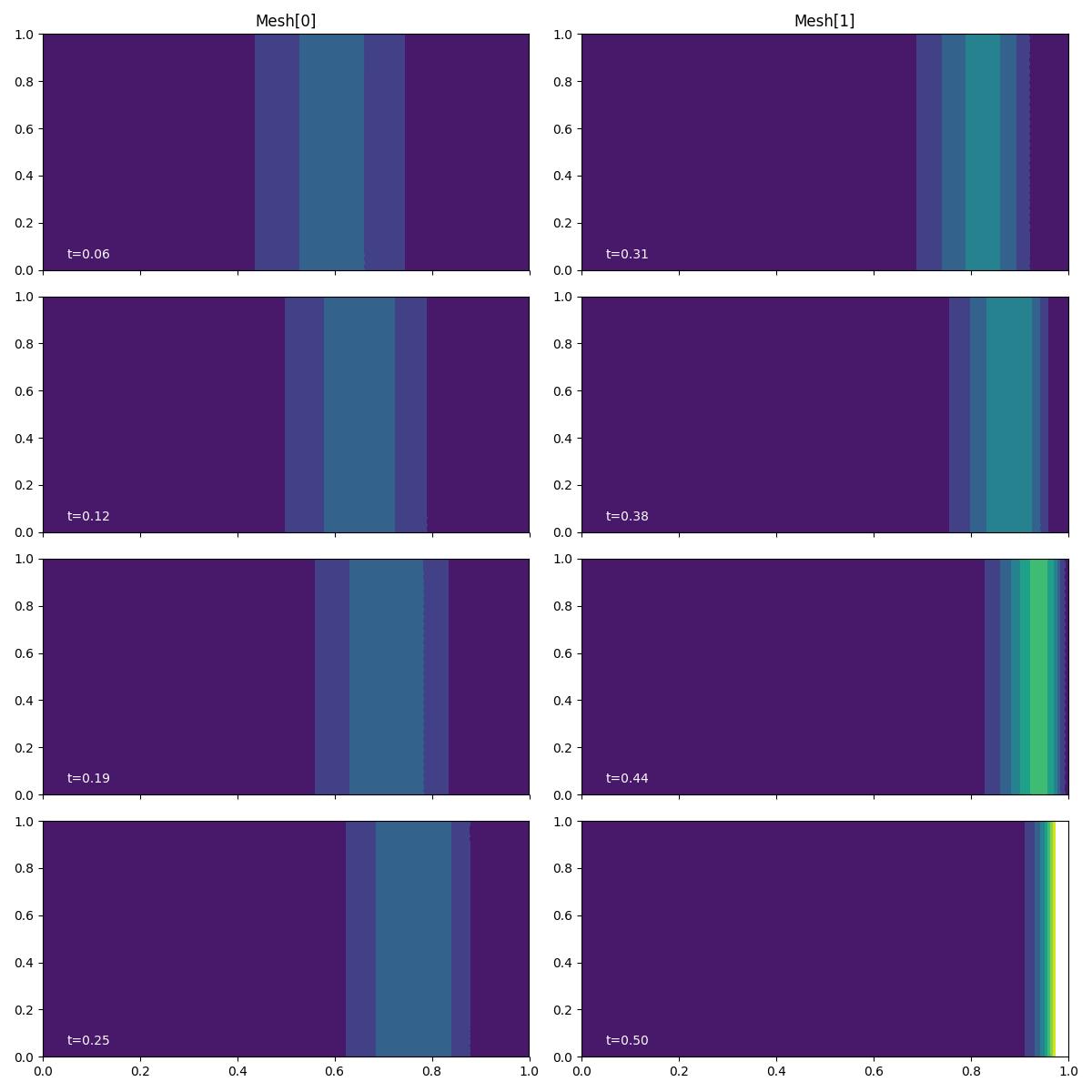Adjoint Burgers equation on two meshes¶
This demo solves the same adjoint problem as the previous one, but now using two subintervals. There is still no error estimation or mesh adaptation; the same mesh is used in each case to verify that the framework works.
from firedrake import *
from goalie import *
set_log_level(DEBUG)
Redefine the meshes and field metadata as in previous demos, as well as all the
getter functions. In this case, we make the default diagonal=”left” keyword argument
to UnitSquareMesh explicit. (See later.)
n = 32
mesh = UnitSquareMesh(n, n, diagonal="left")
fields = [Field("u", family="Lagrange", degree=2, vector=True)]
def get_solver(mesh_seq):
def solver(index):
u, u_ = mesh_seq.field_functions["u"]
# Define constants
R = FunctionSpace(mesh_seq[index], "R", 0)
dt = Function(R).assign(mesh_seq.time_partition.timesteps[index])
nu = Function(R).assign(0.0001)
# Setup variational problem
v = TestFunction(u.function_space())
F = (
inner((u - u_) / dt, v) * dx
+ inner(dot(u, nabla_grad(u)), v) * dx
+ nu * inner(grad(u), grad(v)) * dx
)
# Time integrate from t_start to t_end
tp = mesh_seq.time_partition
t_start, t_end = tp.subintervals[index]
dt = tp.timesteps[index]
t = t_start
while t < t_end - 1.0e-05:
solve(F == 0, u, ad_block_tag="u")
yield
u_.assign(u)
t += dt
return solver
def get_initial_condition(mesh_seq):
fs = mesh_seq.function_spaces["u"][0]
x, y = SpatialCoordinate(mesh_seq[0])
return {"u": Function(fs).interpolate(as_vector([sin(pi * x), 0]))}
def get_qoi(mesh_seq, i):
def end_time_qoi():
u = mesh_seq.field_functions["u"][0]
return inner(u, u) * ds(2)
return end_time_qoi
This time, the TimePartition is defined on two subintervals.
end_time = 0.5
dt = 1 / n
num_subintervals = 2
time_partition = TimePartition(
end_time,
num_subintervals,
dt,
fields,
num_timesteps_per_export=2,
)
mesh_seq = AdjointMeshSeq(
time_partition,
mesh,
get_initial_condition=get_initial_condition,
get_solver=get_solver,
get_qoi=get_qoi,
qoi_type="end_time",
)
solutions = mesh_seq.solve_adjoint()
Recall that solve_forward() runs the solver on each subinterval and
uses conservative projection to transfer inbetween. This also happens in
the forward pass of solve_adjoint(), but is followed by running the
adjoint of the solver on each subinterval in reverse. The adjoint of
the conservative projection operator is applied to transfer adjoint solution
data between meshes in this case. If you think about the matrix
representation of a projection operator then this effectively means taking
the transpose. Again, the meshes (and hence function spaces) are identical,
so the transfer is just the identity.
Snapshots of the adjoint solution are again plotted using the
plot_snapshots() utility function.
fig, axes, tcs = plot_snapshots(
solutions, time_partition, "u", "adjoint", levels=np.linspace(0, 0.8, 9)
)
fig.savefig("burgers2-end_time.jpg")

The adjoint solution fields at each time level appear to match those due to the previous demo at each timestep. That they actually do coincide is checked in Goalie’s test suite.
Exercise
Note that the keyword argument diagonal="left" was passed to the
UnitSquareMesh constructor in this example, defining which way
the diagonal lines in the uniform mesh should go. Instead of having
both function spaces defined on this mesh, try defining the second
one in a \(\mathbb P2\) space defined on a different mesh
which is constructed with diagonal="right". How does the adjoint
solution change when the solution is trasferred between different
meshes? In this case, the mesh-to-mesh transfer operations will no
longer simply be identities.
In the next demo, we solve the same problem but with a QoI involving an integral in time, as well as space.
This demo can also be accessed as a Python script.